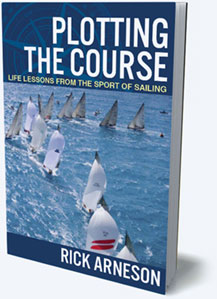I recently read an interesting new book by Mark Gabrielson titled Deer Isle’s Undefeated America’s Cup Crews, and was struck not only by its unique take on a couple of the notable Cup matches of the late nineteenth century, but also how some of the issues that arose over a century ago came up again in the match of 2013.
Crew Nationality
Crew nationality has been a hot topic lately as we anticipate the thirty-fifth America’s Cup, but prior to the match of 1895, the issue was addressed for the ninth defense. Crews to that point had generally been Scandinavian professionals, but skipper Hank Haff insisted that the New York Yacht Club ought to be able to field an all-American crew. They found the men they needed not only in the same country, but in the same town–the little fishing port of Deer Isle, Maine.
Protests Over Ballasting
Controversy over the movement of ballast by the defender cast a cloud over the 1895 match. Lord Dunraven, the challenger, was convinced that the crew of Defender added ballast in the middle of the night after the yacht had already been measured, to gain an advantage in the match. Dunraven’s unsuccessful protest of the issue lasted long after the Cup match had been sailed. In a similar scenario, Cup watchers will recall how recent defender Oracle Team USA was penalized two points for moving ballast on their entry during the AC World Series.
One-Boat Racing
The 1895 match also had a one-boat race at the end of its series. After losing the first race and being disqualified for a collision in the second, Dunraven’s crew on Valkyrie III started the third race and then turned around and went back to the dock, leaving Defender to sail the course alone. Similarly in the first challenger round robin for 2013, the Luna Rossa team refused to come out to race in their first match against Emirates Team New Zealand, as logistical issues for the management of the series continued to be hashed out on shore. Between this and the absence of the Artemis team while they finished construction of their boat, the Kiwis had a very lonesome challenger series, often going around the course by themselves.
Revolutionary Rudders
Rudder design became a topic of discussion in those days, as well. Much as the subtle differences in the rudders on the AC 72 catamarans made a major difference in performance, there was great intrigue surrounding the rudder of 1899 Cup winner Columbia, which was built hollow to allow the taking on of water ballast and thus the adjustment of the yacht’s sailing lines. This innovation would be used again in the design of future Cup defender Reliance.
Gabrielson’s book is an interesting read full of lesser-known facts and interesting anecdotes about the matches of 1895 and 1899 and the winning crews behind them, but it also stands as a reminder of how easy it is for the past to repeat itself. In both America’s Cup history or world history, the tendency of the past to serve as prologue remains consistent. It’s only sensible then to view history not as old news to be discarded, but as a potential preview of scenarios to come.
Good Sailing!
-Rick
Rick Arneson, M.B.A., is the author of Plotting the Course and a competitive sailor with over three decades of sailing experience.
Tags: America's Cup, History, Sailing Books












